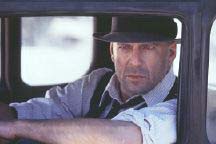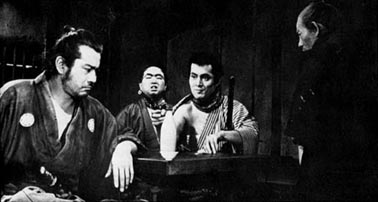
The name makes it clear what Red Harvest is about. This is a bloodbath, perfect material for Tarantinism: a nameless stranger arrives in a town dominated by ruthless gangs, and contrives to have the gangs kill each other off. That's about it. It has been claimed that Yojimbo was based on The Glass Key, another Hammett novel, but about the only thing Kurosawa took from The Glass Key is the beating of Ned Beaumont (without the sexual subtext provided by William Bendix and Alan Ladd in the 1942 film). The presence of this scene in a movie, especially the presence of the specific wounds inflicted on the nameless stranger (as in A Fistful of Dollars and The Warrior and the Sorceress), indicates the film is a remake of Yojimbo and not a version of Red Harvest. (At least one Internet database properly cites Red Harvest for both Yojimbo and Last Man Standing, but not for A Fistful of Dollars, a clear remake of Yojimbo.) On this count, Last Man Standing lines up with Yojimbo. There is no beating in Red Harvest.
It is not necessary that the hero be nameless, merely a fact that he is in Red Harvest, Yojimbo, and A Fistful of Dollars. Toshiro Mifune's character in Yojimbo claims the name "Sanjuro," but that this is an alias of the moment is clear from the context. David Carradine's character in The Warrior and the Sorceress is called Kain, the name of Carradine's character in Kung Fu. Bruce Willis's character in Last Man Standing is "John Smith."
The presence of other characters also indicates a relationship. In Last Man Standing, our hero makes his base camp at a tavern, complete with a friendly tavern keeper, who is his source of information on the town. This parallels Yojimbo and A Fistful of Dollars, but not Red Harvest, where base camp is a hotel room. The unwilling mistress of a gang leader also appears in Yojimbo, A Fistful of Dollars, and Last Man Standing, but not in Red Harvest—though the character of Mrs. Donald Willson fulfills some of the same functions. On the other hand, Last Man Standing has Christopher Walken as a scar-faced thug with a voice problem. This character does not appear in Yojimbo or A Fistful of Dollars, but is clearly based on Whisper Thayer from Red Harvest. Similarly, Bruce Dern's corrupt sheriff is from Chief Noonan, while Alexandra Powers's hardbitten moll is from Dinah Brand: characters from Red Harvest with no analogs in Yojimbo or A Fistful of Dollars. Walter Hill claims that his sources and inspirations were Yojimbo and James M. Cain, but that "when I finished a draft of the screenplay, I remember thinking, 'Damn, this almost reads like Hammett.'" Is it possible he then made the resemblance stronger by including in the next draft some of Hammett's characters as well as his situation?
 Perhaps the most important distinction to be made among the films is the motivation of the main character. Why do the Continental Op, Sanjuro, the Man With No Name, and John Smith reap the red harvest?
Perhaps the most important distinction to be made among the films is the motivation of the main character. Why do the Continental Op, Sanjuro, the Man With No Name, and John Smith reap the red harvest?
We are never given to know what drives John Smith (he is the only one of the four who feels the need to explain himself through voice-over, and still we are least clear about him). We are given a smokescreen about some allegorical battle between good and evil, but so far as we can tell, all he wants is revenge: he was minding his own business, and they started the rough stuff; this is the First Blood syndrome, not the stuff of heroism. And make no mistake about it: Sanjuro, the Continental Op, and the Man With No Name are heroes.
The motivation of the Man With No Name is also cloudy, but at least there is no taint of mere vengeance: he precipitates the action, and only halfway through does he get something to avenge. Also along the way he acquires the motive of protecting the innocents of the village, though it's clear that was not his original reason for being there. There appears to exist, though I have never seen it, a short prologue in which Clint Eastwood's MWNN is released from prison with the charge of cleaning up this town. This, at least, gives him a clear reason for acting the way he does, though the fact that the movie stands so well without it indicates that it isn't necessary. So why does he do it? Maybe he just doesn't like bullies.
The Continental Op has a job to do. He is a hard-boiled private dick; like Sam Spade, like Philip Marlowe, he has a personal code of honor, and that alone drives him. His client has been murdered before he is truly on the case, so he coerces the client's father (Elihu Willson, the town boss) to hire him to clean up the town, no holds barred and no calling him off till the job is done. His motives are at the same time intensely personal and completely professional.
 Sanjuro has, perhaps, the purest motives, being both impersonal and pedagogical. A ronin, a masterless samurai, he lives by violence; it is his life as well as his profession. When he wanders into this village and sees thoughtless, almost random violence carried out by thoughtless, almost random amateurs, he is both appalled and affronted. He sets out to teach these villagers, these peasants, a lesson they will never forget: Leave violence to the professionals, who how to use it and, more important, how to not use it. He is an idealist like the Continental Op, but his idealism is universal. He is a romantic like John Smith, but is not burdened with concepts like Good versus Evil. He is a sentimentalist like the Man With No Name, going out of his way to protect the innocent, but never becomes personally involved. He is the Man of War who yearns for peace, the Bodyguard who must guard the body from itself. He shows the villagers death to make them see life.
Sanjuro has, perhaps, the purest motives, being both impersonal and pedagogical. A ronin, a masterless samurai, he lives by violence; it is his life as well as his profession. When he wanders into this village and sees thoughtless, almost random violence carried out by thoughtless, almost random amateurs, he is both appalled and affronted. He sets out to teach these villagers, these peasants, a lesson they will never forget: Leave violence to the professionals, who how to use it and, more important, how to not use it. He is an idealist like the Continental Op, but his idealism is universal. He is a romantic like John Smith, but is not burdened with concepts like Good versus Evil. He is a sentimentalist like the Man With No Name, going out of his way to protect the innocent, but never becomes personally involved. He is the Man of War who yearns for peace, the Bodyguard who must guard the body from itself. He shows the villagers death to make them see life.
What are we left with in the end, then? Where does Last Man Standing fit in?
Well, try this: in so far as Yojimbo is a version of Red Harvest, so is Last Man Standing. And where Last Man Standing diverges from Yojimbo, it converges with Red Harvest. I have always been surprised that there has been no explicit film version of Red Harvest, especially with the rise of Quentin and all the Tarantinistas (though many have apparently tried: 1930's Roadhouse Nights, perhaps the only one to make it through production, is Red Harvest without any red and with hardly any harvesting). It is perhaps typical of the American film industry that to transport this story from Prohibition-era Colorado (or Idaho) to Prohibition-era Texas they went through Medieval Japan. And pretend they started out in Japan all the while.

